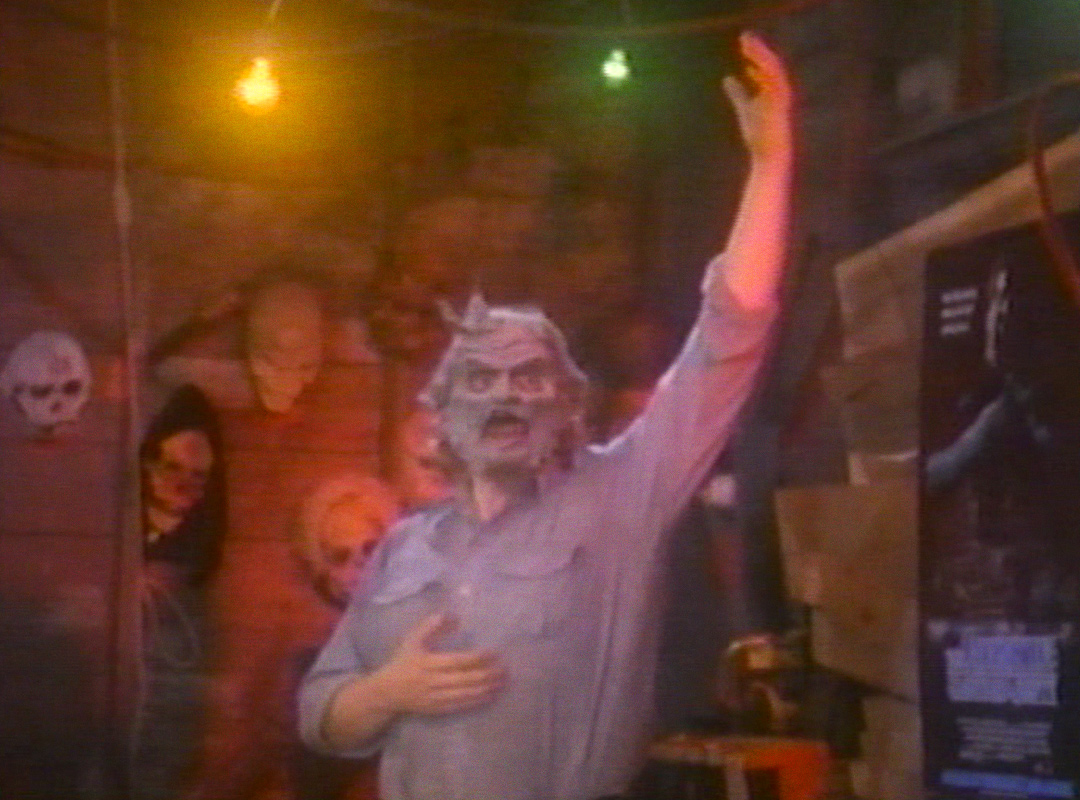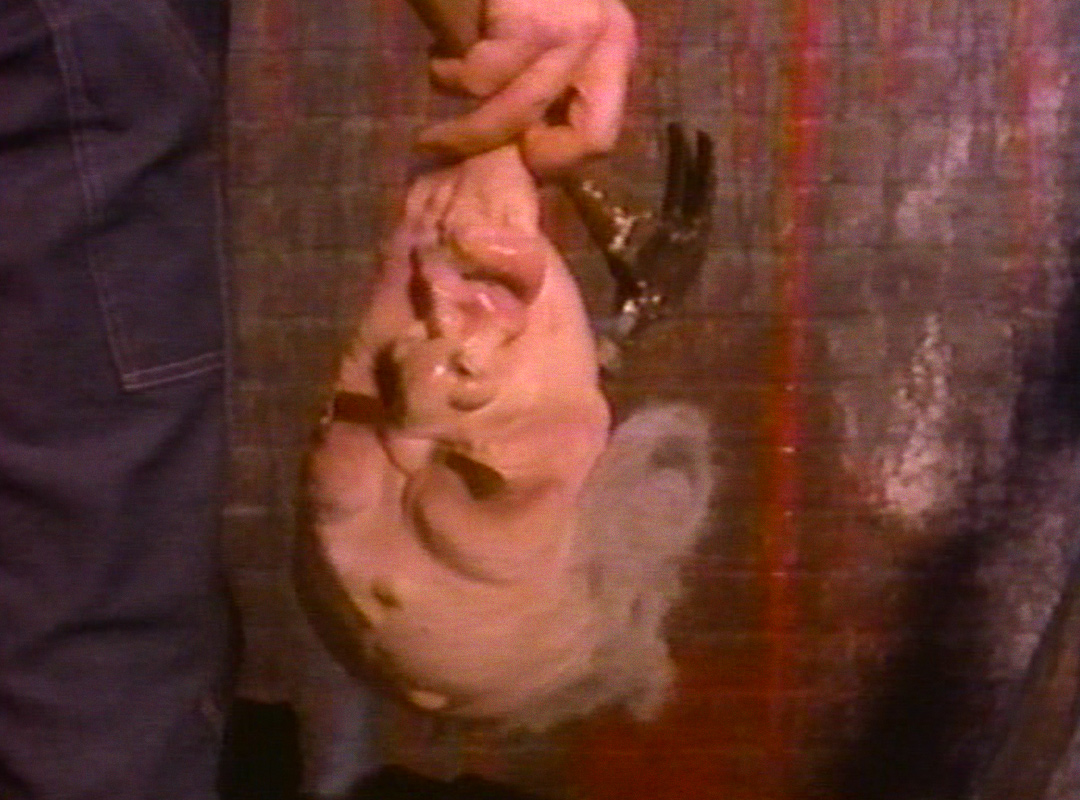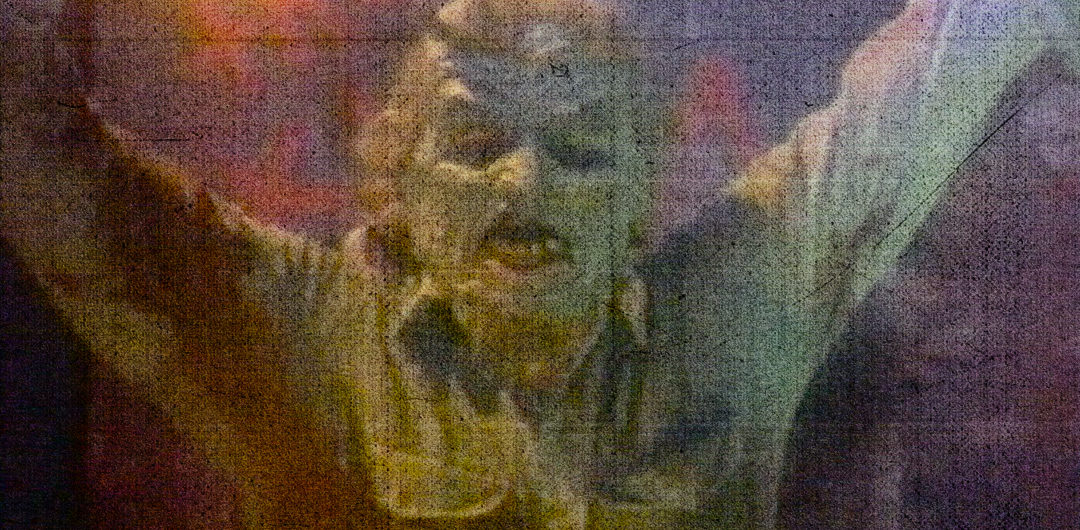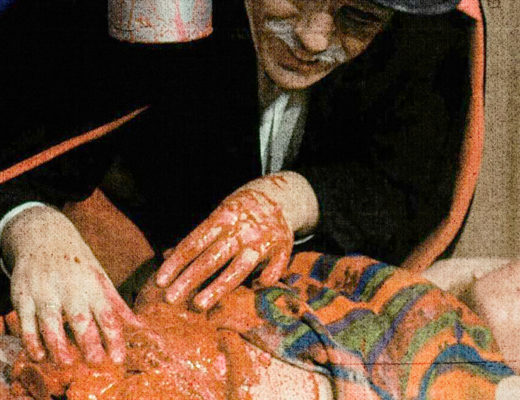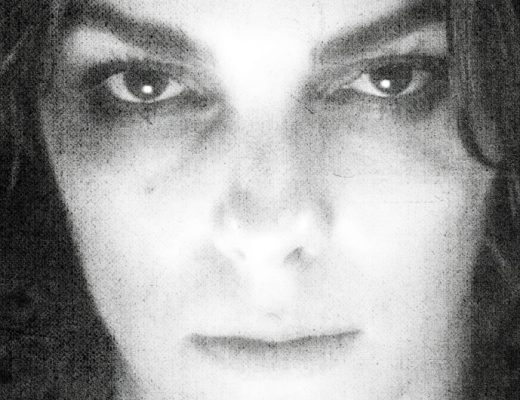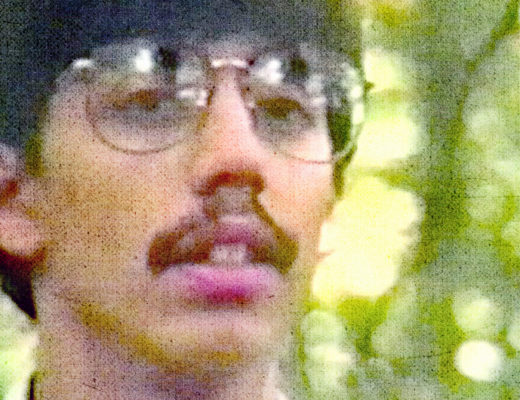Why celebrate Halloween when you can celebrate Hauntedween?
Filmed on 16mm in Kentucky and Tennessee, Hauntedween is the only slasher in history to combine Little Richard impressions, “Foot Locker SLAM FEST!” t-shirts, and a gore-soaked haunted house on Halloween night. Goofy, fun, and oozing with the warmth of no-budget ambition, this movie is a new Halloween tradition for weirdos who like it when adults wearing Hawaiian swim trunks get decapitated by a killer with a baseball bat.
The film follows the story of Eddie Bruber, a grade-schooler who accidentally impales a girl in a spookhouse on Halloween night. Twenty years later, the house is re-opened for fraternity fundraiser. Big mistake. Because grown-up Eddie dons a series of rubber monster masks and turns his vengeful wrath on the customers of the haunted house . . . FOR REAL!
Filmmaker Doug Robertson tells us how it all happened.
Bleeding Skull: Were you aware of other regional horror movies that were shot on 16mm and released straight-to-video in the early 1990s (Dead Girls, The Night Brings Charlie, Soul Of The Demon)? If so, did these types of movies inspire your decision to make Hauntedween? If not, what did inspire you?
Doug Robertson: I shot my movie in August of 1989. We finally got it to video stores in July, 1991. I’m not a horror movie fan. I still don’t watch them today. They scare the crap out of me. The special effects these days are so real, I can almost feel death. When I was young, because of John Carpenter and Halloween, I guess you could say he inspired me. We are both from Bowling Green, Kentucky. We had the same creative writing teacher in college, albeit, we were twenty years apart. He wrote a movie called The Fog in that class. I guess I felt like I could do it because someone else in that same seat did it before me. But my most honest answer to who inspired me is very simple. Every producer that ever made a movie is my inspiration. All movies are different, like children. There is no right or wrong path to get to the end. You are only graded by one measure — did you make it to the finish line? Once your movie is for rent of for sale, check that box and call it a success. Now it’s up to the public to decide if it is any good. But if they are watching it, you did your job. My motivation was, and always had been, to get a movie to the video store and see it for rent. I still remember walking into Blockbuster and seeing ten VHS copies of Hauntedween for rent. That was fun.
BS: What was your background prior to making the movie?
DR: I was a TV and Film major at Western Kentucky University. And I have always been a salesman. I was able to get my friends, family, and local businesses to support my efforts. It was a community project. No one got paid and the budget was right around $65,000. That money was very well spent on everything except talent and crew. That was our deal. If the movie made money, then we would get paid. But I asked them to do it not for the money, but the fun. I was very well organized and had shot the movie many times in my head before the first camera set-up. I was amazed. We didn’t have one accident and no one quit. We made it fun for everyone.
BS: Why the Halloween setting? Did the title come together before the basic idea of the movie?
DR: It’s funny that you never see a pumpkin in my movie. There weren’t any trick or treaters. I came up with the title while living in Los Angeles. It just seemed at the time a good title to market. Later, I found out it was a horrible title. Everyone got it confused and couldn’t pronounce it. Then after a few years, the title settled in. Now they get it. It seems to me such a logical title. Mix Halloween and Haunted to make Hauntedween. But I distinctly remember creating the title before writing the film. I thought it would be a good title to market he movie. I was wrong early on about that.
BS: There’s a Variety issue from 1989 that has a “filming begins” blurb for Hauntedween. Did you know about that? It’s mind-blowing that a backyard horror movie from Kentucky got a mention in a Hollywood trade magazine.
DR: It’s funny that you saw that. I took a class in Hollywood called “Making A Movie For Under 100K.” It was taught by DOV SS Simmons. He had a personal license plate — “PCEOSHT.” He taught us how to make Piece Of Shit movies and how to make money with them. I never set out to to make a piece of shit. But that was his attitude. In that class, he taught us how to talk to the media. He showed us how to get our film in Variety. Mostly, he was very good at making a small film look like a big budget Hollywood movie. If anyone asked about the budget, the standard answer was “under one million.” That was a small budget back them. It’s a tiny budget now. I wrote the press release that got us into Variety then I answered the phone from Variety to validate my film. I remember Hauntedween was right next to Dances With Wolves in the “FILMING In The U.S.” section. So that wasn’t an accident. That was a carefully planned maneuver to set us up for distribution later down the road.
BS: Someone shoots a shotgun into the back of car in this movie. Then the car blows up. How did you pull this off?!
DR: I think that was day nineteen of our shooting schedule. I got an explosives expert from Fort Campbell, Kentucky. I had to pay him $1000 to blow up the van. He brought the dynamite and we provided the location. We did one explosion with multiple cameras filming. That scene required a suspension of disbelief. We had to hope that the audience would believe that Kurt could pull off one lucky shot. I guess he hit the gas tank. That’s what we hoped the audience would believe.
BS: Tell us about the locations. Was the movie shot in Greenville exclusively?
DR: The movie was made in Bowling Green, Kentucky, Gallatin, Tenessee, and Rich Pond, Kentucky. We were given an old warehouse in downtown Bowling Green that we used for a studio. That was for all of the interior Haunted House shots. We shot for a few days around Western Kentucky University. And we used the Sigma Alpha Epsilon fraternity house for some of the movie. It was big and spacious for our equipment needs.
BS: Hauntedween was self-distributed on VHS. That’s really ambitious. Why did you decide to self-release and how did you make it work?
DR: We sold Hauntedween in the summer of 1991 in Las Vegas at the VSDA (Video Software Dealers Association) convention. I paid $1,500 for a booth, made arrangements for some actors to join us and to sell directly into video stores. At the time, we sold into twenty-two states across the country. I think we did close to $22,000 in sales. Even though I was offered three distribution contracts, I decided to go it alone. None of the offered contracts were money up front. So I figured, any sales we made was a good thing. If you sign a contract for a net deal, there will never be any money. If you sign a gross deal, on such a small movie, you will likely need a lawyer to enforce the contract. Small films lose most every time in Hollywood. Now we are in an environment that direct to consumer sales are making small projects worthwhile again.
BS: What happened after the release of the movie? Were there other film projects that you worked on?
DR: My major at WKU was film and TV production. I made a few corporate videos after Hauntedween. But I found my niche in medical sales. I’ve been doing that since 1992 and it’s a good living. I’ve always been a sales person and a marketing guy. At this point in my life — I am fifty now — I doubt I will ever launch into another feature film. But it was the most fun summer I have ever had in my life. And it was the best learning experience as well. The challenges of making a film are ridiculous. Just when you think the day will be normal, five things happen to derail you offtrack. One thing I learned about myself is that I have a filmmaker personality. I can tolerate utter chaos and make sense out of it. I’m very good and making decisions on the fly. If you are a control freak or a precise planner, filmmaking will put you in the hospital. You have to be able to go with the flow, let the film happen, and realize your crew is your best friend. But the circuitous route to getting there will be very interesting.
BS: These days, what comes to mind when you think of Hauntedween?
DR: I remember fun times, a few secrets, and what an amazing accomplishment. Three months of writing after work in Los Angeles, six weeks of pre-production in Bowling Green, twenty-two (eighteen hour) days of production with Sundays off and then almost two years to get it into video stores. I took ten years to finally pay it off. But mostly, I feel proud that I did it. It’s rare to have a dream in this world and accomplish it. I never thought about the financial consequences. I just dealt with it. Actually, I thought I was going to make money. Then reality set in. But it was mine. That financial mess was really one of my best decisions ever. My divorce in 2004 cost me many times more than Hauntedween. So I guess marriage proved to be way riskier than making a small movie. All in all, I’m happy that there is still interest in Hauntedween. It’s not the best movie, but it’s definitely not the worst. That’s saying something.
